
India’s first solar observatory successfully reaches intended orbit
The first Indian solar observatory has successfully reached its intended orbit, the country’s Space Research Organisation announced Saturday, as India seeks to cement its status as an emerging space superpower.
The Aditya-L1 spacecraft safely arrived at Lagrange Point L1, the position in space with unobstructed views of the sun located about 1.5 million kilometers (almost a million miles) from Earth, paving the way for scientists to enhance their study of the Sun-Earth System.
Indian Prime Minister Narendra Modi applauded the “extraordinary feat” in a post on X on Saturday, adding that this “is a testament to the relentless dedication of our scientists in realizing among the most complex and intricate space missions.”
The Aditya-L1 launched on September 2, less than two weeks after the ISRO made a historic landing of its Chandrayaan-3 spacecraft on the moon’s South Pole.
The spacecraft is equipped with seven scientific instruments, four of which will be trained directly on the sun while the others will study solar wind particles and magnetic fields passing through at Lagrange Point L1.
The main goals of the mission include studying the sun’s upper atmosphere and various solar phenomena, such as coronal mass ejections — or massive expulsions of plasma from the sun’s outermost layer.
The information gleaned from Aditya-L1’s experiments will provide a clearer picture of space weather, or the term used to describe the magnetic waves rippling through our solar system. Space storms can have an impact on Earth when they reach our atmosphere, occasionally affecting satellites, radio communications and even power grids, according to the US National Oceanic and Atmospheric Administration.
India’s Aditya-L1 will add to information gathered on other missions designed to study the sun, including NASA’s ongoing Parker Solar Probe that in 2021 became the first spacecraft to “touch” the sun.
